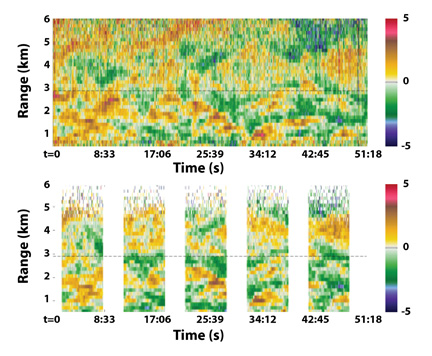Emerging Lidar Technique
Emerging Lidar Technique Shows Promise for Simplified Wind Measurements
September 2011 – Philip Larkin, NASA ESTO
![]()
The accurate, reliable, long-term weather forecasts of tomorrow will depend largely on improved measurements of wind speed and direction within the troposphere, the lowest 5 to 12 miles of the atmosphere. To make persistent global wind measurements a reality, a fundamentally new kind of spaceborne instrument is required. An emerging lidar technology, the Optical Autocovariance Wind Lidar (OAWL) under development at Ball Aerospace, may offer a novel solution.
Current in-situ and airborne wind sensors, including balloon-sondes and drop-sondes, work well for localized measurements. It would be far too cumbersome and costly, however, to use these kinds of instruments globally at anywhere near the needed coverage, particularly over the oceans. Space-borne microwave scatterometers, such as the SeaWinds instruments on the QuikSCAT and ADEOS II satellites, infer wind speed and direction by measuring ocean surface roughness. But this method provides a limited, 2-dimensional look at winds at or just above the surface of the ocean.
Dopper wind lidar (DWL) shows the most promise for 3-dimensional, truly-global, tropospheric wind measurements from space. DWL systems are not new; they’ve been used on the ground, on ships, and on airplanes for years.
Coherent DWL, which is used extensively to study the lower troposphere, bounces a near-infrared (1.5-10 μm) laser off the aerosols in the atmosphere to measure how fast they (and thus the wind) are moving. This technique works well where aerosols are plentiful. In regions with few aerosols, or ‘clean’ air, another technique known as direct detection DWL uses ultraviolet (355 nm) laser light to detect the motion of the constituent molecules in the atmosphere. Though direct detection measurements are typically less-precise than coherent measurements, they require no aerosol presence and can make measurements throughout the troposphere where coherent systems cannot. The concept for the NASA 3D-Winds mission proposes, therefore, that one of each instrument type fly together to measure winds across a variety of atmospheric conditions.
The OAWL system offers an alternative to the two-instrument design and may produce a simpler, more cost-effective path to global wind measurements. OAWL uses a 355 nm laser, like a direct detection DWL, to measure winds from aerosol backscatter with precision similar to coherent DWL. The design will integrate an existing direct detection technique so that the system can measure winds from both aerosol and molecular returns using the single laser.
During two weeks of ground testing at the Colorado Table Mountain Field Site and Radio Quiet Zone in July 2011, OAWL made line-of-sight wind measurements alongside NOAA’s mini-MOPA coherent detection Doppler lidar, an established reference ground sytem. The tests show correlation of over 90% between OAWL and mini-MOPA measurements. The OAWL project team has also scheduled airborne validation tests onboard the NASA WB-57 airplane in Fall 2011, again in conjunction with ground-based wind lidar wind measurements
OAWL (top) and mini-MOPA (bottom) data returns from 7/13/11 (colors represent line of sight wind speed, from -5 m/s to 5 m/s, see colorbar)
Once the technique is proven, OAWL could fly regular airborne missions in support of atmospheric science and be scaled for a future flight in space. The OAWL technology enables a simplified system, with a single laser and common optical components, that would reduce cost and complexity for a mission like 3D-Winds.
For more information on emerging technologies for Earth science, visit the NASA Earth Science Technology Office website.
![]()

A view of the Table Mountain, CO, test range.
